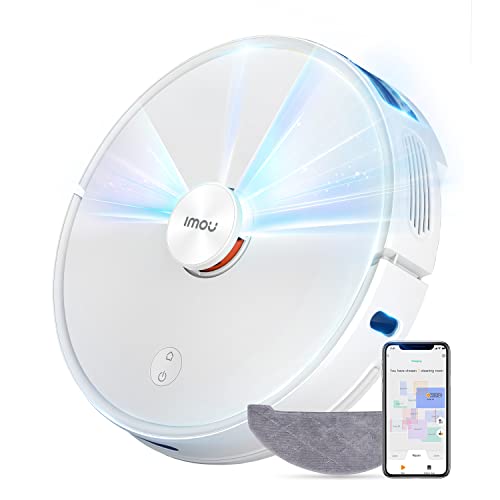The 10 Most Scariest Things About Robot Vacuum Lidar
페이지 정보

본문
 Lidar Mapping and lidar robot vacuums Mapping in Robot Vacuum Cleaners
Lidar Mapping and lidar robot vacuums Mapping in Robot Vacuum CleanersLidar shines a laser into the room and detects reflections of obstacles and surfaces to create a real-time map. This information can help the robot avoid collisions.
 A mapping robot vacuum alters its cleaning patterns based on the floor plan that it has learned, enhancing each session for efficiency.
A mapping robot vacuum alters its cleaning patterns based on the floor plan that it has learned, enhancing each session for efficiency.Object Detection
Robot vacuums typically come with several sensors and other systems to assist them in navigating your home. These can include LIDAR and camera systems. Lidar (Light detection and Ranging), uses laser beams to measure distances, as well as creating a 3D environment map. It uses time of flight to determine the amount of time it takes for each beam to be hit and returned from objects within the space. This gives the robot a clear view of its surroundings.
The robot utilizes this information to determine its location and design the best route to avoid obstacles. The precision and accuracy of lidar make it more efficient than other mapping technologies, like cameras, for navigating and avoiding obstacles. It can be enhanced by other data, like the inclination in the floor to aid in navigation.
Object recognition helps robots avoid collisions and other messes. It can identify an array of objects such as socks, shoes and pet waste and determine their size and location to ensure that the robot does not get them in the way or drag them. In contrast to obstacle avoidance systems which depend on a mechanical or an ultrasonic sensor, object recognition can recognize objects in low-light conditions, and also detect reflective or transparent objects.
The cameras that are used by traditional robotic vacuums can detect large obstacles like furniture and walls, but they might miss smaller objects like cables or wires. Robot vacuums that have LIDAR and object detection are able to avoid these obstacles with greater ease and get to the places you'd like them to clean faster.
Some models have a button that lets you create virtual walls and boundaries which can help the robot stay clear of certain objects or areas that you don't want it touch. This is a great method of separating important or sensitive objects, such as guitars and vases. This feature is available on a number of robots that use LIDAR. However, it's less common with cameras-based systems.
It is important to know that Lidar, while a powerful technology for mapping and navigation is not invincible to hacking. In fact, a new side-channel attack that uses acoustics called LidarPhone can exploit the lidar sensor of popular robots like the Xiaomi Roborock and others. Researchers looked into ARM Cortex M based firmware on these devices and exploited a vulnerability in the Dustcloud Software stack to gain root. They were capable of recording spoken numbers and music with an average of 91 percent accuracy.
Mapping
Mapping is the process through which a robot vacuum makes a digital map of a home or room. This is accomplished by sending a laser beam which scans the surrounding area several times per second, and then draws an internal map of every area. It then uses this map to navigate the home more efficiently and ensure that each area is cleaned. Mapping technology is more precise than gyroscopes and cameras-based navigation systems.
A robotic vacuum equipped with an electronic mapping system is typically able to perform more thorough cleaning than one that does not have it. The robot can move around the room more efficiently instead of bouncing around randomly or getting stuck in corners. It is also able to avoid obstacles better and may even be able to recognize invisible objects like cords and wires.
Lidar is a standard type of mapping technology for robot vacuums. It makes use of a mix of sensors to measure distance and direction, as well as the ability to see through walls. Lidar sensors may be a bit more expensive than gyroscopes or cameras, but they offer superior performance and accuracy. They are less affected by changes in lighting conditions and perform better on reflective or transparent surfaces.
SLAM (Simultaneous Mapping and Localization) is a popular mapping technology used by robot vacuums. This technique combines visual data from cameras and gyroscopes. This will allow the robot to determine its position in the space, and also build a detailed map of the surrounding. This allows the robot to navigate around obstacles precisely and efficiently plan cleaning routes. This can reduce the number of steps required for completing a task.
Compared to mapping systems that use only gyroscopes, robotics that use SLAM are less likely to be stuck or bump into objects. They can also perform a variety of tasks simultaneously including sweeping and mopping and can also create virtual no-go zones that keep them out of areas that you don't would like them to go. This is particularly useful in homes with children or pets, as it allows you to ensure that the robot is kept away from fragile items or areas in which electrical cords are.
Distance Measurement
Robot vacuum cleaners need to know the distance of obstacles in order to function effectively. The lidar technology (Light Detection & Ranging) is a game changer and allows robot vacuum lidar; visit the next website page, cleaners to make detailed maps that improve navigation.
Lidar sensors emit laser beams that bounce off objects in a room and return to the sensor, measuring the duration of flight to calculate distance measurements. The sensor can then create maps of the surfaces within the room which includes furniture, walls and other obstacles. The data is fed into the robot's navigational system which allows the robot to avoid collisions and follow the optimal cleaning routes for maximum efficiency.
In contrast to older, budget-friendly robots that relied on bumpers or simple infrared sensors, top-of-the-line models with Lidar technology can scan the entire floor surface and spot even the tiniest obstacles. This lets the robot plan efficient cleaning routes that encompass every inch of your property by eliminating repeated and missed spots. The ECOVACS HOME app can also display the entire map of your home and allow you to select areas that need extra attention.
While Lidar-equipped vacs provide many advantages, they are generally more expensive than those which use simpler navigation systems. The good news is that technological advancements are constantly being made that will eventually reduce the cost of lidar sensor robot vacuum sensors. This feature will be more affordable to a wider consumer base.
Recent research revealed that hackers could exploit the lidar sensors on robot vacuum cleaners to listen in on private conversations and steal sensitive data, such as credit cards numbers or personal information. Researchers developed a specially-designed device that exploited the lidar readings to record audio signals. The researchers then processed the data to analyze patterns of sound and reveal private conversations, without the owner's knowledge.
Although this attack is at a fairly early stage it reveals the weaknesses in the security protocols currently used for smart devices. It's crucial for users to keep up-to-date with the latest security updates and keep their robot vacuum with object avoidance lidar vacuums current.
Navigation
Combining Lidar with SLAM navigation on robot vacuum cleaners has revolutionized the way that these machines map and navigate through space. This system is more precise, efficient and adaptable to changing conditions than previous technologies. It has opened new possibilities for these robotic household assistants.
LiDAR operates by emitting laser beams and measuring the time it takes for those beams to hit an object and return. The sensor can then build a detailed map of the objects and surfaces within the room in real-time. This data is then used to accurately detect the shape and location of these items and surfaces, allowing the robot to determine its route and move around them effortlessly.
This is a more accurate method than cameras, which can be easily fooled by similar textures and colors as well as being less effective in darkness. Lidar is not just used to map the space but also allows the robot to establish its own location, which is essential for planning and avoiding collisions.
Using this information, the robot will determine the most efficient route to follow and clean your entire house, ensuring that it covers all areas that need to be cleaned without wasting effort or getting stuck on obstacles. It is also able determine if there are stairs and other obstacles that must be avoided.
The best robot vacuums with SLAM and lidar sensor vacuum cleaner are the ones that combine these technologies to offer the most accurate and reliable navigation on the market. If you take a look at the navigation of a device, you can tell whether it is using SLAM. It tends to move in straight lines and clings to corners and edges with ease. This is a stark contrast with older technologies that used to have random navigation patterns and bounced around from one obstacle to the next.
A few simpler robots might utilize gyroscopes to navigate, which work by determining the direction and speed of the wheels' rotation. This is a tried-and-tested method that is found in planes, cars, and even phones. It is very effective in preventing robots from bumping into objects and also creating a basic map. However, it is not as precise and reliable as other systems, and might not be suitable for use in extremely large homes.
- 이전글What's The Job Market For Sleeping Couch And Sofa Professionals? 24.08.25
- 다음글10 Key Factors Regarding Electric Wheelchairs Lightweight You Didn't Learn In The Classroom 24.08.25
댓글목록
등록된 댓글이 없습니다.

